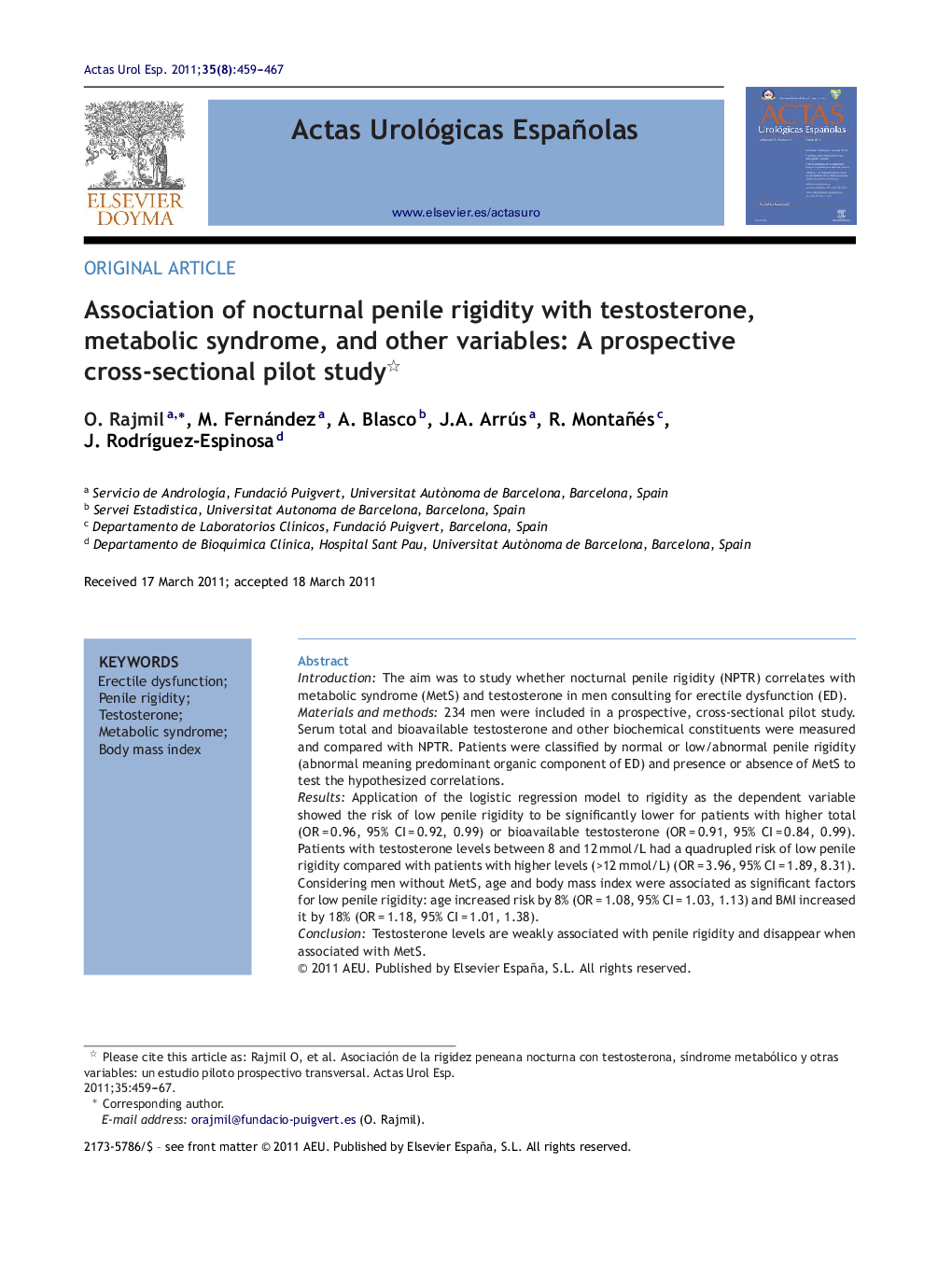| کد مقاله | کد نشریه | سال انتشار | مقاله انگلیسی | نسخه تمام متن |
|---|---|---|---|---|
| 3845687 | 1248285 | 2011 | 9 صفحه PDF | دانلود رایگان |

IntroductionThe aim was to study whether nocturnal penile rigidity (NPTR) correlates with metabolic syndrome (MetS) and testosterone in men consulting for erectile dysfunction (ED).Materials and methods234 men were included in a prospective, cross-sectional pilot study. Serum total and bioavailable testosterone and other biochemical constituents were measured and compared with NPTR. Patients were classified by normal or low/abnormal penile rigidity (abnormal meaning predominant organic component of ED) and presence or absence of MetS to test the hypothesized correlations.ResultsApplication of the logistic regression model to rigidity as the dependent variable showed the risk of low penile rigidity to be significantly lower for patients with higher total (OR = 0.96, 95% CI = 0.92, 0.99) or bioavailable testosterone (OR = 0.91, 95% CI = 0.84, 0.99). Patients with testosterone levels between 8 and 12 mmol/L had a quadrupled risk of low penile rigidity compared with patients with higher levels (>12 mmol/L) (OR = 3.96, 95% CI = 1.89, 8.31). Considering men without MetS, age and body mass index were associated as significant factors for low penile rigidity: age increased risk by 8% (OR = 1.08, 95% CI = 1.03, 1.13) and BMI increased it by 18% (OR = 1.18, 95% CI = 1.01, 1.38).ConclusionTestosterone levels are weakly associated with penile rigidity and disappear when associated with MetS.
ResumenIntroducciónEl objetivo fue estudiar la relación entre la rigidez de las erecciones nocturnas (NPTR) con el síndrome metabólico (SM) y la testosterona en varones que consultan por trastornos de erección (DE).Material y métodoSe incluyeron 234 varones en un estudio piloto prospectivo y transversal. Se midieron los niveles séricos de testosterona total y biodisponible y otros parámetros bioquímicos relacionados con el SM y con las NPTR. Los pacientes se agruparon según la rigidez de las erecciones: normales (alta rigidez, componente predominante psicológico de la disfunción) o anormales (baja rigidez, posible componente orgánico o físico de la DE) y por la presencia o ausencia de SM.ResultadosEl modelo de regresión logística para la rigidez del pene como variable dependiente demostró que el riesgo de rigidez anormal es menor en individuos con mayor testosterona total (OR = 0,96; 95% CI = 0,92, 0,99) o biodisponible (OR = 0,91; 95% CI = 0,84, 0,99). Pacientes con niveles de testosterona entre 8 y 12 mmol/L presentaron un riesgo cuatro veces mayor de tener rigidez anormal comparados con aquellos con niveles superiores a 12 mmol/L (OR = 3,96; 95% CI = 1,89, 8,31). Si se consideraban únicamente aquellos varones sin MetS, solo la edad y el índice de masa corporal aparecían como factores de riesgo asociados a la rigidez anormal. La edad aumentó el riesgo de rigidez anormal en un 8% (OR = 1,08; 95% CI = 1,03, 1,13) y el MI lo aumentó en un 18% (OR = 1,18; 95% CI = 1,01, 1,38).ConclusiónLa asociación de niveles de testosterona con la rigidez del pene fue baja y desaparece si se asocia con SM.
Journal: Actas Urológicas Españolas (English Edition) - Volume 35, Issue 8, September 2011, Pages 459–467